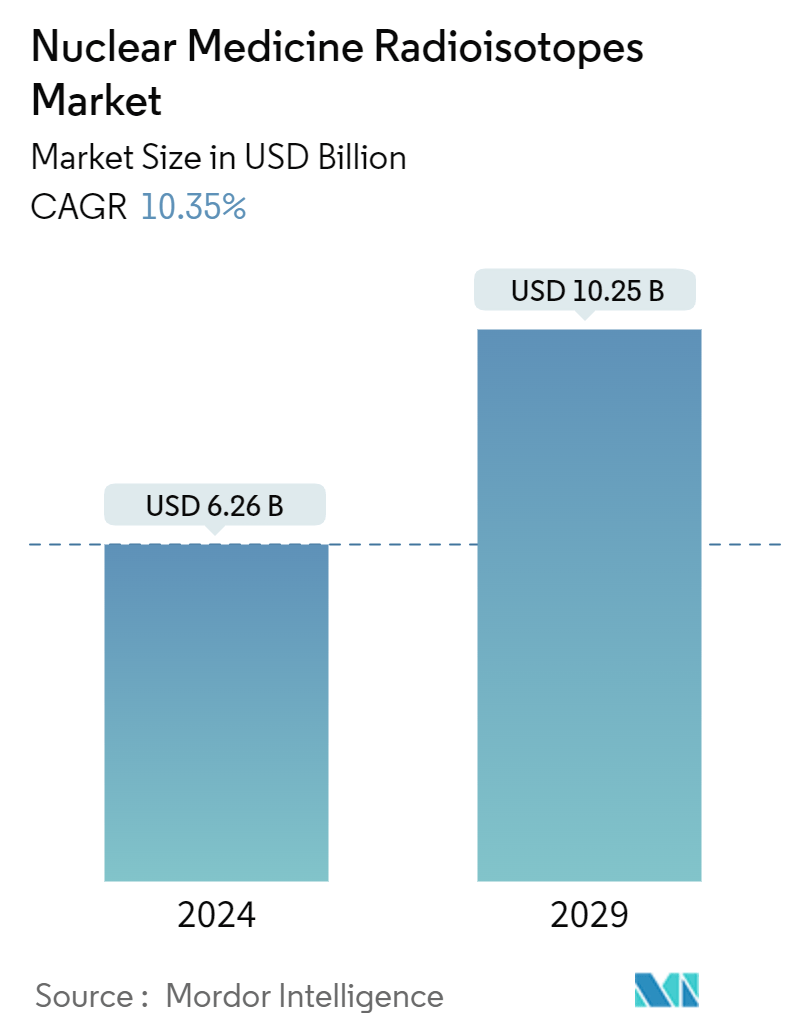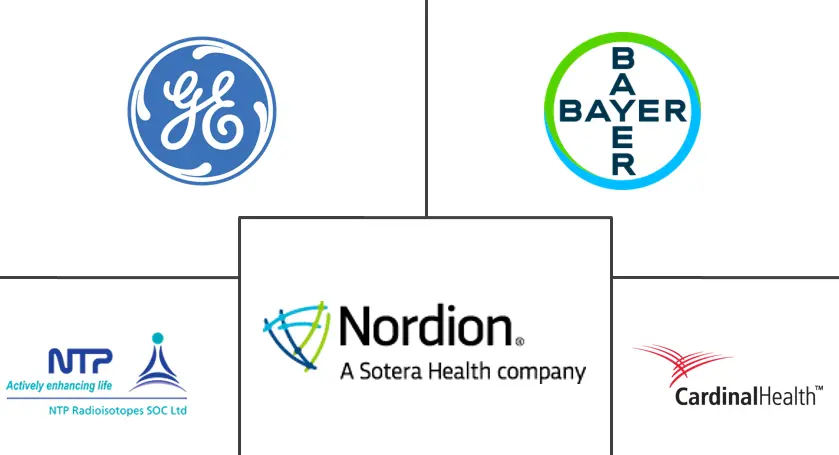Market Size of Nuclear Medicine Radioisotopes Industry

| Study Period | 2019 - 2029 |
| Market Size (2024) | USD 6.26 Billion |
| Market Size (2029) | USD 10.25 Billion |
| CAGR (2024 - 2029) | 10.35 % |
| Fastest Growing Market | Asia Pacific |
| Largest Market | North America |
| Market Concentration | Medium |
Major Players
*Disclaimer: Major Players sorted in no particular order |
Nuclear Medicine Radioisotopes Market Analysis
The Nuclear Medicine Radioisotopes Market size is estimated at USD 6.26 billion in 2024, and is expected to reach USD 10.25 billion by 2029, growing at a CAGR of 10.35% during the forecast period (2024-2029).
The COVID-19 pandemic had an adverse impact on the nuclear medicine radioisotopes market initially with the temporary cancellation or postponement of the non-COVID diagnosis and treatment such as nuclear medicine. For instance, as per a study published in ScienceDirect Journal in June 2021, the number of nuclear studies, nuclear cardiac imaging, and oncology PET/CT decreased during the pandemic due to the rise of COVID-19 cases and deaths. The study further stated that procedures increased from June 2020 to February 2021 as COVID-19 cases declined.
However, with the decrease in COVID-19 cases since early 2022, the market is reaching its pre-pandemic nature in terms of radiology procedures, which is boosting the demand for nuclear medicine radioisotopes. For instance, data published by the Radiological Society of North America (RSNA) in December 2022 stated that Radiologic Research in the North American region resumed. Thus, the COVID-19 outbreak had an adverse impact on the market's growth in its preliminary phase. Moreover, the market is expected to grow further at a normal pace with the resumption of nuclear medicine diagnosis and the increasing demand for nuclear medicine radioisotopes globally.
Further, the nuclear medicine radioisotopes market is expected to grow further due to the rising burden of cancer and cardiac disorders, widening applications of nuclear medicine, increasing SPECT and PET applications, and increasing patient awareness of radiation and radiation therapy. The upsurge in the global incidence of cancer and modern healthcare facilities has been a major driver of the market's growth. For instance, according to data published by the Canadian Cancer Society in May 2022, it was estimated that over 30,000 individuals in Canada would be diagnosed with lung and bronchus cancer. This represented an increase of 13% in the cases of lung and bronchus cancer from 2021 to 2022. It was also estimated that over 20,700 lives would be claimed by the disease in 2022.
Furthermore, according to the statistics published by Macmillan Cancer Support in October 2022, the number of people living with cancer is expected to increase in the coming years in the United Kingdom. The source stated that in the United Kingdom, over 3.5 million cases of cancer are estimated in 2025, and further to 4.0 million in 2030. Thus, the high prevalence of such chronic diseases would create a huge demand for nuclear imaging diagnosis for the management of diseases globally. Thus, all these factors are responsible for driving the market's growth.
Moreover, the key developments by the market players in the area of nuclear medicine radioisotopes are contributing to the market's growth. For instance, in February 2022, Blue Earth Diagnostics, a Bracco company and recognized leader in the development and commercialization of innovative PET radiopharmaceuticals, revealed the upcoming oral presentation of key results from its Phase 3 SPOTLIGHT trial of 18F-rhPSMA-7.3 in recurrent prostate cancer at the upcoming ASCO 2022 Genitourinary Cancers Symposium (ASCO GU).
Furthermore, in December 2021, GE Healthcare launched its most advanced SPECT/CT, a nuclear medicine system, at RSNA21. Such developments are anticipated to boost the development of radioisotopes, thereby contributing to the market's growth.
Therefore, owing to the aforementioned factors, including the high burden of chronic diseases, wide applications of nuclear medicine radioisotopes, and key developments by the market players, the studied market is anticipated to witness growth over the analysis period. However, reimbursement complications and regulatory issues are likely to impede market growth.
Nuclear Medicine Radioisotopes Industry Segmentation
As per the scope of the report, medical radioisotopes are defined as safe radioactive substances that are primarily used in the diagnosis of medical conditions. These radioisotopes, used in a diagnosis, emit gamma rays of energy that are sufficient to escape from the body. The rays also have a short half-life, which is appropriate since the rays can decay as soon as the imaging is completed.
The nuclear medicine radioisotopes market is segmented into by type of radioisotope, application and geography. By type of radioisotopes, the market is segmented as Technetium-99m (Tc-99m), Thallium-201 (Tl-201), Iodine (I-123), Fluorine-18, Rubidium-82 (Rb-82), Iodine-131 (I-131), Lutetium-177 (Lu-177), Radium-223 (Ra-223) and Alpharadin, Actinium-225 (Ac-225), and other types of radioisotopes. By application, the market is segmented as oncology, cardiology, thyroid, neurology, and other applications. The report offers the market size in value terms in USD for all the abovementioned segments.
| Type of Radioisotopes | |
| Technetium-99m (Tc-99m) | |
| Thallium-201 (Tl-201) | |
| Iodine (I-123) | |
| Fluorine-18 | |
| Rubidium-82 (Rb-82) | |
| Iodine-131 (I-131) | |
| Lutetium-177 (Lu-177) | |
| Radium-223 (Ra-223) and Alpharadin | |
| Actinium-225 (Ac-225) | |
| Other Types of Radioisotopes |
| By Application | |
| Oncology | |
| Cardiology | |
| Thyroid | |
| Neurology | |
| Other Applications |
| By Geography | ||||||||
| ||||||||
| ||||||||
| ||||||||
| Rest of the World |
Nuclear Medicine Radioisotopes Market Size Summary
The nuclear medicine radioisotopes market is poised for significant growth over the forecast period, driven by the increasing prevalence of chronic diseases such as cancer and cardiovascular disorders. The market is recovering from the initial setbacks caused by the COVID-19 pandemic, which had temporarily disrupted diagnostic and treatment procedures. As the demand for nuclear medicine radioisotopes rises, fueled by advancements in SPECT and PET applications, the market is expected to expand steadily. The growing awareness of radiation therapy and its applications in various medical fields further supports this growth trajectory. Key developments by market players, including innovative product launches and strategic collaborations, are also contributing to the market's expansion.
In North America, the market is experiencing growth due to technological advancements and the introduction of new radioisotopes for diagnosis. The increasing burden of chronic diseases, such as Alzheimer's and cancer, is driving the demand for nuclear medicine radioisotopes, which play a crucial role in clinical diagnosis. Market players are actively engaging in strategies like mergers, acquisitions, and partnerships to enhance their market presence. The competitive landscape is characterized by the presence of major players such as NTP Radioisotopes SOC Ltd, Bayer AG, and GE Healthcare, who are continuously innovating to meet the rising demand. Overall, the market is expected to witness robust growth, supported by the expanding applications of nuclear medicine and ongoing technological advancements.
Nuclear Medicine Radioisotopes Market Size - Table of Contents
-
1. MARKET DYNAMICS
-
1.1 Market Overview
-
1.2 Market Drivers
-
1.2.1 Rising Burden of Cancer and Cardiac Disorders
-
1.2.2 Widening Applications of Nuclear Medicine
-
1.2.3 Increasing SPECT and PET Applications
-
1.2.4 Increasing Patient Awareness on Radiation and Radiation Therapy
-
-
1.3 Market Restraints
-
1.3.1 Reimbursement Complications
-
1.3.2 Regulatory Issues
-
-
1.4 Porter's Five Forces Analysis
-
1.4.1 Threat of New Entrants
-
1.4.2 Bargaining Power of Buyers/Consumers
-
1.4.3 Bargaining Power of Suppliers
-
1.4.4 Threat of Substitute Products
-
1.4.5 Intensity of Competitive Rivalry
-
-
-
2. MARKET SEGMENTATION (Market Size by Value - USD)
-
2.1 Type of Radioisotopes
-
2.1.1 Technetium-99m (Tc-99m)
-
2.1.2 Thallium-201 (Tl-201)
-
2.1.3 Iodine (I-123)
-
2.1.4 Fluorine-18
-
2.1.5 Rubidium-82 (Rb-82)
-
2.1.6 Iodine-131 (I-131)
-
2.1.7 Lutetium-177 (Lu-177)
-
2.1.8 Radium-223 (Ra-223) and Alpharadin
-
2.1.9 Actinium-225 (Ac-225)
-
2.1.10 Other Types of Radioisotopes
-
-
2.2 By Application
-
2.2.1 Oncology
-
2.2.2 Cardiology
-
2.2.3 Thyroid
-
2.2.4 Neurology
-
2.2.5 Other Applications
-
-
2.3 By Geography
-
2.3.1 North America
-
2.3.1.1 United States
-
2.3.1.2 Canada
-
2.3.1.3 Mexico
-
-
2.3.2 Europe
-
2.3.2.1 Germany
-
2.3.2.2 United Kingdom
-
2.3.2.3 France
-
2.3.2.4 Italy
-
2.3.2.5 Spain
-
2.3.2.6 Rest of Europe
-
-
2.3.3 Asia-Pacific
-
2.3.3.1 China
-
2.3.3.2 Japan
-
2.3.3.3 India
-
2.3.3.4 Australia
-
2.3.3.5 South Korea
-
2.3.3.6 Rest of Asia-Pacific
-
-
2.3.4 Rest of the World
-
-
Nuclear Medicine Radioisotopes Market Size FAQs
How big is the Nuclear Medicine Radioisotopes Market?
The Nuclear Medicine Radioisotopes Market size is expected to reach USD 6.26 billion in 2024 and grow at a CAGR of 10.35% to reach USD 10.25 billion by 2029.
What is the current Nuclear Medicine Radioisotopes Market size?
In 2024, the Nuclear Medicine Radioisotopes Market size is expected to reach USD 6.26 billion.

